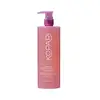What's inside
What's inside
 Key Ingredients
Key Ingredients

 Benefits
Benefits

 Concerns
Concerns

 Ingredients Side-by-side
Ingredients Side-by-side

Water
Skin ConditioningSodium C14-16 Olefin Sulfonate
CleansingAloe Barbadensis Leaf Juice
Skin ConditioningGlycerin
HumectantCocamidopropyl Betaine
CleansingCocamidopropyl Hydroxysultaine
CleansingSodium Methyl Cocoyl Taurate
CleansingPhenoxyethanol
PreservativeSodium Benzoate
MaskingParfum
MaskingCocos Nucifera Water
MaskingPolyquaternium-7
Chlorphenesin
AntimicrobialCitric Acid
BufferingGuar Hydroxypropyltrimonium Chloride
Skin ConditioningDecyl Glucoside
CleansingAlgae Extract
EmollientArgania Spinosa Kernel Oil
EmollientGluconolactone
Skin ConditioningWater, Sodium C14-16 Olefin Sulfonate, Aloe Barbadensis Leaf Juice, Glycerin, Cocamidopropyl Betaine, Cocamidopropyl Hydroxysultaine, Sodium Methyl Cocoyl Taurate, Phenoxyethanol, Sodium Benzoate, Parfum, Cocos Nucifera Water, Polyquaternium-7, Chlorphenesin, Citric Acid, Guar Hydroxypropyltrimonium Chloride, Decyl Glucoside, Algae Extract, Argania Spinosa Kernel Oil, Gluconolactone
Water
Skin ConditioningSodium C14-16 Olefin Sulfonate
CleansingPolyacrylate-1 Crosspolymer
Sodium Cocoamphoacetate
CleansingHamamelis Virginiana Water
AstringentGluconolactone
Skin ConditioningMandelic Acid 1%
AntimicrobialHoney
HumectantCamellia Oleifera Leaf Extract
AstringentVitis Vinifera Seed Extract
AntimicrobialActinidia Deliciosa Fruit Extract
Skin ConditioningGlycerin
HumectantCocamidopropyl Hydroxysultaine
CleansingSodium Benzoate
MaskingAlcohol
AntimicrobialEthylhexylglycerin
Skin ConditioningPropanediol
SolventPhenoxyethanol
PreservativeWater, Sodium C14-16 Olefin Sulfonate, Polyacrylate-1 Crosspolymer, Sodium Cocoamphoacetate, Hamamelis Virginiana Water, Gluconolactone, Mandelic Acid 1%, Honey, Camellia Oleifera Leaf Extract, Vitis Vinifera Seed Extract, Actinidia Deliciosa Fruit Extract, Glycerin, Cocamidopropyl Hydroxysultaine, Sodium Benzoate, Alcohol, Ethylhexylglycerin, Propanediol, Phenoxyethanol
Ingredients Explained
These ingredients are found in both products.
Ingredients higher up in an ingredient list are typically present in a larger amount.
Cocamidopropyl Hydroxysultaine is a synthetic cleansing agent, though it is derived from coconut oil.
It is used to enhance the texture of products by boosting lather and thickening the texture. As a cleanser, Cocamidopropyl Hydroxysultaine is mild.
Gluconolactone is a PHA. PHAs are a great gentle alternative to traditional AHAs.
When applied, Gluconolactone has the same affect on skin as AHAs such as lactic acid. It helps dissolve the dead skin cells in the top layer of your skin. This improves texture and brightens the skin.
PHAs are more gentle than AHAs due to their larger structure. They do not penetrate as deeply as AHAs and take a longer time to dissolve dead cells. Studies show PHAs do not cause as much irritation.
Gluconolactone has some interesting properties:
In a 2004 study, Gluconolactone was found to prevent UV damage in mouse skin cells and has not been found to increase sun sensitivity. However, we still recommend wearing SPF daily.
This ingredient is is an created by reacting gluconic acid with an alcohol.
Learn more about GluconolactoneGlycerin is already naturally found in your skin. It helps moisturize and protect your skin.
A study from 2016 found glycerin to be more effective as a humectant than AHAs and hyaluronic acid.
As a humectant, it helps the skin stay hydrated by pulling moisture to your skin. The low molecular weight of glycerin allows it to pull moisture into the deeper layers of your skin.
Hydrated skin improves your skin barrier; Your skin barrier helps protect against irritants and bacteria.
Glycerin has also been found to have antimicrobial and antiviral properties. Due to these properties, glycerin is often used in wound and burn treatments.
In cosmetics, glycerin is usually derived from plants such as soybean or palm. However, it can also be sourced from animals, such as tallow or animal fat.
This ingredient is organic, colorless, odorless, and non-toxic.
Glycerin is the name for this ingredient in American English. British English uses Glycerol/Glycerine.
Learn more about GlycerinPhenoxyethanol is a preservative that has germicide, antimicrobial, and aromatic properties. Studies show that phenoxyethanol can prevent microbial growth. By itself, it has a scent that is similar to that of a rose.
It's often used in formulations along with Caprylyl Glycol to preserve the shelf life of products.
Sodium Benzoate is a preservative. It's used in both cosmetic and food products to inhibit the growth of mold and bacteria. It is typically produced synthetically.
Both the US FDA and EU Health Committee have approved the use of sodium benzoate. In the US, levels of 0.1% (of the total product) are allowed.
Sodium benzoate works as a preservative by inhibiting the growth of bacteria inside of cells. It prevents the cell from fermenting a type of sugar using an enzyme called phosphofructokinase.
It is the salt of benzoic acid. Foods containing sodium benzoate include soda, salad dressings, condiments, fruit juices, wines, and snack foods.
Studies for using ascorbic acid and sodium benzoate in cosmetics are lacking, especially in skincare routines with multiple steps.
We always recommend speaking with a professional, such as a dermatologist, if you have any concerns.
Learn more about Sodium BenzoateSodium C14-16 Olefin Sulfonate is a cleansing agent made from a mixture of long chain sulfonate salts. It can also help produce foam.
This ingredient may be drying. We recommend speaking with a professional if you have concerns.
Water. It's the most common cosmetic ingredient of all. You'll usually see it at the top of ingredient lists, meaning that it makes up the largest part of the product.
So why is it so popular? Water most often acts as a solvent - this means that it helps dissolve other ingredients into the formulation.
You'll also recognize water as that liquid we all need to stay alive. If you see this, drink a glass of water. Stay hydrated!
Learn more about Water